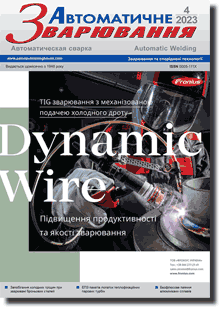| 2023 №04 (06) |
DOI of Article 10.37434/as2023.04.07 |
2023 №04 (08) |

"Avtomatychne Zvaryuvannya" (Automatic Welding), #4, 2023, pp. 41-49
Evaluation of the influence of chemical composition of filler wires on weldability of D16 aluminium alloy
T.M. Labur, V.A. Koval, M.R. Yavorska
E.O. Paton Electric Welding Institute of the NAS of Ukraine. 11 Kazymyr Malevych Str., 03150, Kyiv, Ukraine. E-mail: office@paton.kiev.uaAluminium alloy of D16 grade is widely used in aircraft industry, but at nonconsumable electrode arc welding it demonstrates a susceptibility to solidifi cation (“hot”) cracking in the weld and zone of fusion with the base metal. This is associated with the action of the mechanism of high-temperature segregation cracking of the grain boundaries and breaking of metal bonds at metal crystallization, as a result of increase of local residual stress, which reduces the joint strength. Furtheron, the alloy composition was optimized by the quantity of alloying elements and admixtures. At present advanced alloys and welding technologies are used. The objective of the study is evaluation of the conditions of sound weld formation, their strength and ductility characteristics, depending on the chemical composition of batch-produced ZvAK5 and Zv1201 fi ller wires. The fi rst wire widens the silicon content in the weld structure, it will promote lowering of the alloy susceptibility to technological heating and slowing down of metal embrittlement, and the second one is close to the alloy by its chemical composition. It is found that the cracking susceptibility of D16 alloy is determined by arc welding technology, fi ller wire chemical composition, and scheme of its feeding into the weld pool. It is shown that the conditions of consumable electrode welding slow down the realization of metal cracking mechanism, characteristic for nonconsumable electrode welding. The joint mechanical properties here are increased by 10…12 %, depending on fi ller wire composition. 10 Ref., 6 Tabl., 7 Fig.
Keywords: aluminium alloy, nonconsumable and consumable electrode welding, permanent joints, hot cracks, weld structure mechanical properties, investigations
Received: 22.03.2023
References
1. Ishchenko, A.Ya., Labur, T.M. (2013) Welding of modern structures from aluminium alloys. Kyiv, Naukova Dumka [in Russian].2. Wenez, A. (2005) Hundertfuntzig Jahre Aluminium. Der Praktiker, 5, 74–75.
3. (2002) Metal 2002: Good prospects for the future as the Newly Industrialised Countries gain greater importance. IKB Deutsche Industriebank.
4. Ishchenko, A.Ya. (2003) Aluminium high-strength alloys for welded structures. In: Advanced Materials and Technologies, Vol. 1. Kyiv, Akademperiodyka, 50–82 [in Ukrainian].
5. Beletsky, V.M., Krivov, G.A. (2005) Aluminium alloys (composition, properties, technology, application): Refer. book. Ed. by I.N. Fridlyander. Kyiv, Komintekh [in Ruaaian.
6. Milman, Yu.V., Korzhova, N.P., Sirko, A.I. (2008) Aluminium and its alloys. In: Inorganic Materials Science. Metals and technologies. Vol. 2, Book. Kyiv, Naukova Dumka, 52– 68 [in Russian].
7. Zhernosekov, A.M., Andreev, V.V. (2007) Pulsed metal arc welding (Review). The Paton Welding J., 10, 48–51.
8. Mashin, V.S., Poklyatsky, A.G., Fedorchuk, V.E. (2005) Mechanical properties of aluminium alloys in consumable and nonconsumable electrode arc welding. The Paton Welding J., 9, 39-45.
9. Colchen, D. (2000) Application des calculs aux elements fi nis pour defi nir et valider des modeles analytiques de calcul de contrainte sur un assemblage bout a bout en alliage d’aluminium. Soudage et Techniques Сonnexes, 54, 3/4, 3–16.
10. Ishchenko, A.Ya., Lozovskaya, A.V. (2001) Improvement of weldability of aluminium alloys by optimization of quantity of impurities: Problems of current materials science. In: Proc. of 5th Session of Scientifi c Council on New Materials of Intern. Association of Academies of Sciences (May 12, 2000, Kyiv).Gomel, IMMS NANB, 72-77 [in Russian].
Advertising in this issue:
The cost of subscription/purchase order journals or individual articles
| Journal/Currency | Annual Set | 1 issue printed |
1 issue |
one article |
| TPWJ/USD | 384 $ | 32 $ | 26 $ | 13 $ |
| TPWJ/EUR | 348 € | 29 € | 24 € | 12 € |
| TPWJ/UAH | 7200 UAH | 600 UAH | 600 UAH | 280 UAH |
| AS/UAH | 1800 UAH | 300 UAH | 300 UAH | 150 UAH |
| AS/USD | 192 $ | 32 $ | 26 $ | 13 $ |
| AS/EUR | 180 € | 30 € | 25 € | 12 € |
| SEM/UAH | 1200 UAH | 300 UAH | 300 UAH | 150 UAH |
| SEM/USD | 128 $ | 32 $ | 26 $ | 13 $ |
| SEM/EUR | 120 € | 30 € | 25 € | 12 € |
| TDNK/UAH | 1200 UAH | 300 UAH | 300 UAH | 150 UAH |
| TDNK/USD | 128 $ | 32 $ | 26 $ | 13 $ |
| TDNK/EUR | 120 € | 30 € | 25 € | 15 € |
AS = «Automatic Welding» - 6 issues per year;
TPWJ = «PATON WELDING JOURNAL» - 12 issues per year;
SEM = «Electrometallurgy Today» - 4 issues per year;
TDNK = «Technical Diagnostics and Non-Destructive Testing» - 4 issues per year.











